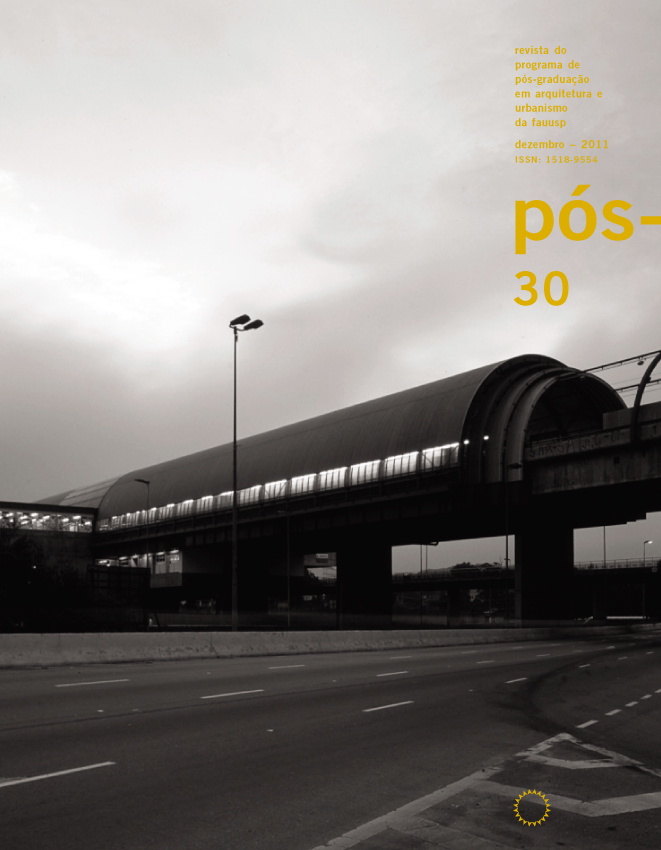Estilo desornamentado, plain-style architecture: some aspects of the renaissance in the Iberian Peninsula
DOI:
https://doi.org/10.11606/issn.2317-2762.v18i30p56-69Keywords:
Plain-style architecture, Estilo desornamentado, Architectural doctrines, Architectural treatises, Portuguese Renaissance, Spanish RenaissanceAbstract
In the sixteenth century, in the Iberian Peninsula, the assimilation of the romano gives impulse to an architectural stream in which a progressive classicism and the decorative nudity announce the arrival of the so-called Renaissance. Despite their peculiarities, the Portuguese plain-style and the Spanish estilo desornamentado set their basis on architectural doctrines originated in Italy. Brought either by the artifices that have been in such lands - or by its architects invited to work in the Peninsula - or by the architectural treatises imported and, afterwards, translated into Spanish and Portuguese, such doctrines also stimulated the publication of other significant texts of theoretical systematization, such as Sagredo´s Medidas del romano. This article discusses such aspects of the Renaissance in the Iberian Peninsula.Downloads
References
ARENAS, José Fernández (Org.) Renacimiento y Barroco en España. Barcelona: Gustavo Gilli, 1982.
BROTHERS, Cammy. The Renaissance reception of the Alhambra. Muqarnas, v. 11, p. 79-102, 1994.
BURY, John. Medidas del Romano. By Diego de Sagredo. In: The Burlington Magazine, v. 131, n. 1, jan. 1989.
CHECA, Fernando. El estilo clásico. In: NIETO, V.; MORALES, A. J.; CHECA, F. Arquitectura del Renacimiento en España. Madri: Manuales Arte Cátedra, 1989.
CONCEIÇÃO, Margarida Tavares da. Learning architecture: early modern apprenticeships in Portugal. In: INTERNATIONAL MEETING EAHN-EUROPEAN ARCHITECTURAL HISTORY NETWORK, 1., Guimarães, Portugal, 17-20 jun. 2010. Disponível em: http://www.ces.uc.pt/myces/UserFiles/encontros/725_Conceicao_EAHN_LearningArchitecture.pdf. Acesso em: Out. 2011.
CORREIA, José Eduardo Horta. Arquitetura portuguesa: Renascimento, Maneirismo, Estilo Chão. Lisboa: Editorial Presença, 1991.
DAMONTE, Mario. La fortuna di Leon Battista Alberti in Spagna nel secolo XVI. Atti della Accademia Ligure di Scienze e Lettere, v. XXIX, p. 354-372, 1972.
GOMES, Paulo Varela. Aspectos do classicismo na arquitectura portuguesa dos séculos XVI e XVII. In: OLIVEIRA, Myriam Andrade de; PEREIRA, Sonia Gomes (Org.). Rio de Janeiro: UERJ, 2004. v. 2, p. 607-633. Apresentado no COLÓQUIO LUSO-BRASILEIRO DE HISTÓRIA DA ARTE, 6., Rio de Janeiro. Anais... Rio de Janeiro: CBHA/PUC/UFRJ, 2004.
JESTAZ, Bertrand. Il Nuovo Linguaggio. In: IL RINASCIMENTO dell’architettura da Brunelleschi a Palladio. Torino: Universale Electa; Galimard, 1995. p. 39-64.
KUBLER, George. Arquitectura portuguesa chã. Entre as especiarias e os diamantes, 1521-1706. Lisboa: Vega, 1972.
MARÍAS, F. El siglo XVI: gótico y renacimiento. Madri: Sílex, 1992.
MORALES, Alfredo J. Tradición y modernidad, 1526-1563. In: NIETO, V.; MORALES, A. J.; CHECA, F. Arquitectura del Renacimiento en España. Madri: Manuales Arte Cátedra, 1989.
MOREIRA, Rafael. Arquitectura: Renascimento e Classicismo. In: PEREIRA, P. (Org.). História da arte portuguesa. Lisboa: Temas e Debates, 1995. v. 2.
MOREIRA, Rafael. A Escola de Arquitetura do Paço da Ribeira e a Academia de Matemáticas de Madrid. In: SIMPÓSIO LUSO-ESPANHOL DE HISTÓRIA DA ARTE, 2., Coimbra, 1987. Anais... Coimbra: Livraria Minerva, 1987.
NIETO, Víctor. Renovación e indefinición estilística, 1488-1526. In: NIETO, V.; MORALES, A. J.; CHECA, F. Arquitectura del Renacimiento en España. Madri: Manuales Arte Cátedra, 1989. p. 337-347.
SERLIO, Sebastiano. The five books of architecture. Toronto: Dover, 1982.
SOROMENHO, Miguel. Classicismo, italianismo e estilo chão. O ciclo filipino. História da arte portuguesa. Lisboa: Temas e Debates, 1995. v. 2.
TAFURI, Manfredo. Ricerca del Rinasciment. Principi, città, architetti. Torino: Einaudi, 1992.
TERZI, Filippo. Architetto e ingegnere militare in Portogallo. Lisboa: [s.n.], 1578.
TOLEDO, Benedito Lima de. Do século XVI ao início do século XIX: maneirismo, barroco e rococó. In: ZANINI, W. (Org.). História geral da arte no Brasil. São Paulo: Instituto Walther Moreira Salles, 1983.
WILKINSON-ZERNER, Catherine. Juan de Herrera. Architect to Philip II of Spain. New Haven and London: Yale University Press, 1993.
WILKINSON, Catherine. Proportion in practice: Juan de Herrera’s design for the façade of the Basilica of the Escorial. The Art Bulletin, Nova York, v. 67, n. 2, p. 229-242, 1985.
WUNDRAM, M.; PAPE, T.; MARTON, P. Andrea Palladio. Um arquitecto entre o Renascimento e o Barroco. Köln: Taschen, 1994.
Downloads
Published
Issue
Section
License

This work is licensed under a Creative Commons Attribution 4.0 International License.
DIADORIM - Diretório de Políticas Editoriais












